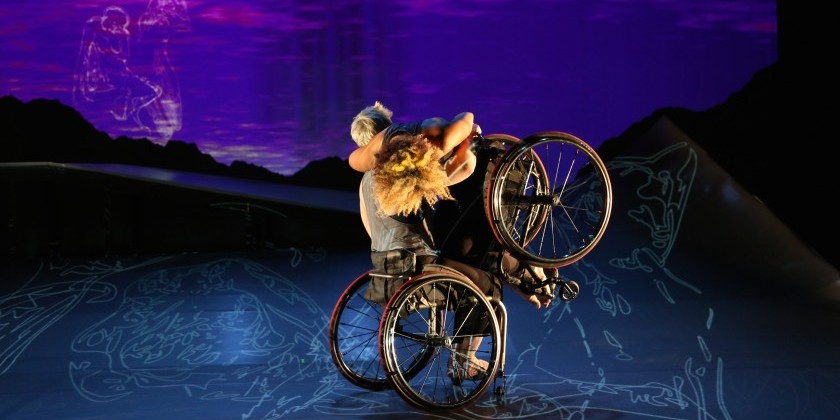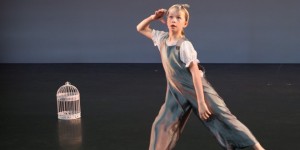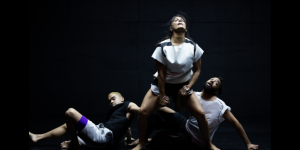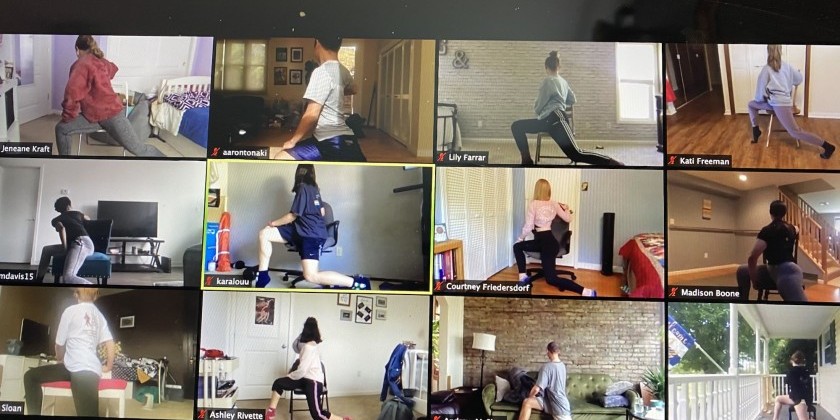At the Intersection of Play, Pleasure and Disability: Kinetic Light's DESCENT Premieres at New York Live Arts

DESCENT is an evening-length duet. DESCENT is a world of organic and fabricated curves, peaks and edges. It is sound and light and space, pure seduction, a gentle caress. DESCENT is a dance, a ride, and a moving manifesto, premiering in New York City, March 22-24.
Choreographer, dancer and founder of Kinetic Light, Alice Sheppard draws inspiration from sensual writings and art of French sculptor Auguste Rodin and gives the mythological characters of Venus and Andromeda new life as interracial lovers. Moving in and out of the wheelchairs, they use in life and performance, dancers, Sheppard and Laurel Lawson, show an entire spectrum of beauty, passion, strength, and new movement possibilities. “We’ve created DESCENT specifically to celebrate disability arts and culture and to demonstrate how disability is an artistic and creative force.”

“[My work] comes from an understanding of disability as culture, disability as community, of disability as aesthetic - disability in an intersectional way,” states Sheppard. In her experience, [disability] “thinks about race, it thinks about gender, it thinks about identity -- so when you have all of that going on, when you’ve got embodied (awareness) and work this hard - and you are working with a partner who’s worked equally as hard, maybe harder... I mean, none of this happens because it’s magic. Well,” she squints and exhales, “it is magic… the ramp is magic.”
With that as our departure, we dive into a rich vein of exploration. Sheppard takes me on a galloping ride through those who influenced her thinking, the thirty-year history of disabled dance, centering on her collision with that lineage. She speaks of how she picked up her piece of this mantle and rolled with it, admitting, that she’s always loved flying down the steepest hills - with abandon. This piece and the development of the ramp has evolved from loads of people telling her it couldn’t be done, to rays of philosophical, narrative hope and research to, finally one connection that led to designer / artist Sara Hendren who pushed the vision forward.

“I think the person who languaged it best was Simi Linton in her book, My Body Politic. She talks about the joys of riding up and down hill and literally names it in a way that I don’t think I’ve ever read before.” As if her crisp British cadence isn’t enough to capture one’s attention, Sheppard is exacting in her mission and clear in her purpose. There is no question about why this work was made or the depth, value, and journey it fulfills. She continued, “[when discussing access ramps, Linton writes] it’s not just whether you can get into the building - it’s how you get into the building, who you get into the building with, how are you living -- it’s a question of pleasure and joy and equality of experience and that [thinking] collided with my physical want to ride down hill.”

I ask about the process of making this work.
“I don’t like the phase ‘making work’,” she leans in, confesses with a broad smile. “Of course that is what’s happening - but I wondered if for this particular piece, would it be ok to think about the work as world-building. I mean it’s a dance, but so much of the labor work and heart work has been about building the world that makes the dance possible. It’s about being open to the world that makes the dance possible and inviting everyone in and you know there’s a dance and the dance is… and around it - under it - beside it, is basically everything I know and everyone I’ve ever met in my whole life.”

With dancer Laurel Lawson, designer, Michael Maag, and artist / design researcher, Sara Hendren, with physics professor Yevgeniya Zastavker and a team of students from Olin College who conceptualized the ramp, Sheppard has created an opportunity for audiences, disabled and nondisabled alike, to have physical experiences of the work. Nondisabled people may not have the lived experiences of the wheelchair users in the audience, yet all report feeling the draw of the ramp, the freedom and strength of expression of the dancers. Sheppard tells stories of looking out over the audience and seeing people swaying, responding, dancing in their seats. At first she wondered why, now she simply trusts that she has created something that people feel, deeply. In collaboration with Maag, the movement threads seamlessly through rich landscapes, projected onto the ramp and dancers with painterly precision. “Michael made a world - where the moving light is as important as the moving body,” emphasizes Sheppard.

I ask about the idea of risk.
“It is really important to introduce to the mainstream world this idea that not only are there these points of work,” of which DESCENT is one, “but we are connected to each other. These are people, [Simi Linton, Rosemarie Garland Thomson, Sara Hendren] who are shifting the public imagination. They speak in terms of play and pleasure. You know the public imagination has tremendous capacity. As human beings, we have these untapped spaces but because of the social discourse around disability and impairment, and around race [and gender]. We have limited our imaginations and we don’t know the spaces that exist. Particularly for disability, most of the public imagination is caught in the restrictions of what people think of as diagnosis.”
“I’ve been working now as a dancer for 12 years,” Sheppard shares. “[The movement vocabulary of DESCENT] didn’t come from nowhere. Over the years my body has changed, my strength has changed - my ways in which I use the body have changed and I’ve worked really hard to have the body that I have to be able to do the things that I do. So even though it looks [risky]... And that’s the other thing, most of these things that are being assessed as risky or dangerous are being assessed by nondisabled people who don’t actually know where the point of risk or balance or dangerousness is, so what looks dangerous to them is merely a matter of technique and training and work. I think that that notion of risk and vulnerability has to do with societal understandings of disability. As can’t or frail or vulnerable - always in this object position of need and want and deficit. My work doesn’t come from that place.”

The ramp is a large factor in what makes this particular piece possible. It is nearly six feet tall and spans twenty four by fifteen feet of stage space. “Laurel and I now have ramp bodies,” says Sheppard. “[The ramp] forces you to relearn everything you know about going down a hill. Because it’s banked and curved - you have to forget what you know and learn what it has to teach. I mean we are on wheels; there are no breaks - the notion of being still relates to finding places to hang, like when we’ve reached the top of the momentum, the top of the curve. We are constantly being torqued and whipped, so it took us a while to learn even how to balance on this thing. And there are limits - we need ten feet of downstage space, because when we come off the ramp it takes ten feet to get back into control.”

Sheppard asserts that, “the ramp is part of the company’s commitment to access as aesthetic, and not an accommodation.” They are experimenting in different ways to create an accessible immersive experience. Tactile 3D printed mini-ramps have been fabricated to allow audience members to hold and trace the ramp with their fingers and hands. While audience cannot play on the ramp themselves, they can feel and imagine the ramp through touch. As the project continues and develops, Kinetic Light will engage in additional experiments including sonification and verbal descriptions as an aesthetic part of creating this immersive experience.
DESCENT opens on March 22nd at New York Live Arts. All shows are currently sold out. Learn more about Kinetic Light at: https://kineticlight.org














